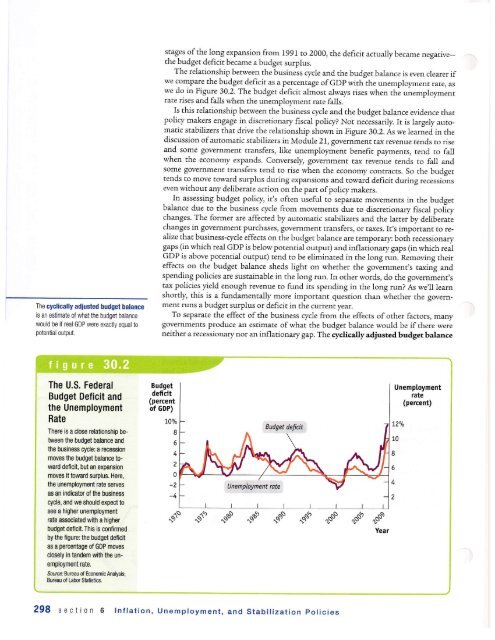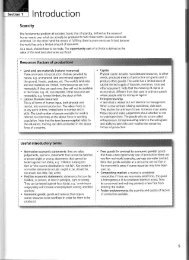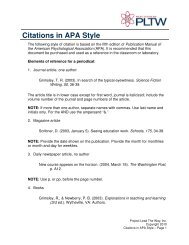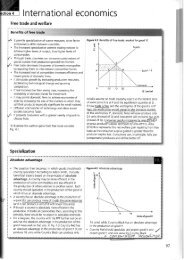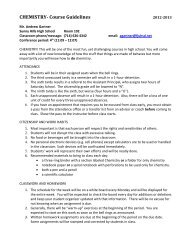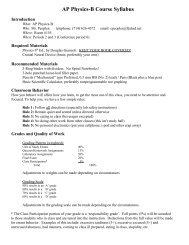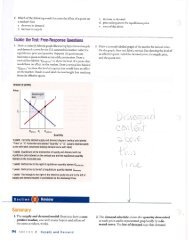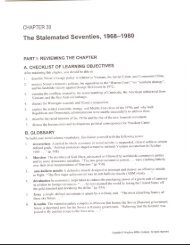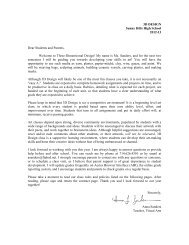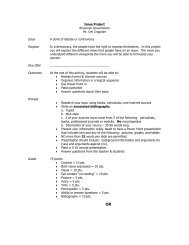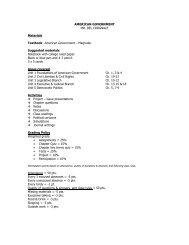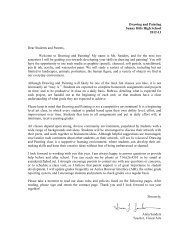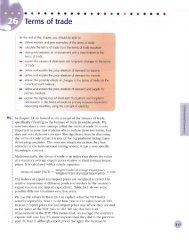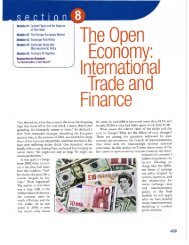AP Econ Module 30 Deficits Debt - Sunny Hills High School
AP Econ Module 30 Deficits Debt - Sunny Hills High School
AP Econ Module 30 Deficits Debt - Sunny Hills High School
You also want an ePaper? Increase the reach of your titles
YUMPU automatically turns print PDFs into web optimized ePapers that Google loves.
The cyclically adlustod budg8l balanc€<br />
is an estmate of what the budget balance<br />
would be ff real GDP were exactly oqual to<br />
potential output.<br />
The U.S. Federal<br />
Budget Deficit and<br />
the Unemployment<br />
Rate<br />
Itrere is a clos€ mlationship be-<br />
twssn fiB budoet balance and<br />
the business cycle: a rscession<br />
moves the budget balance b-<br />
ward dsficlt, but an expansion<br />
moves it toward surplus. Hsre,<br />
the unemployment rate ssrves<br />
as an indicabr of the business<br />
cycle, and we should expect b<br />
see a higher unsmployment<br />
rate a$ociat8d wilh a higher<br />
budget deficit. lhls ls confirmed<br />
by the figure:$e budget deficit<br />
as a percenhge of GDP moves<br />
closoly in tandem wih the un-<br />
employment rate,<br />
Sot rdr. Bumau of <strong>Econ</strong>omic Analysis;<br />
Bu.eau of lalor Shtslics.<br />
stages ofthe long expansion from 1991 to 2000, the deficir actually becarne negative_<br />
the budget deficir became a budget surplus.<br />
The reladonship between the business cycle and the bud.get balance is even clearer if<br />
we cornpare the budget deficit as a percentage ofGDp with the unemplo;,tnent rate, as<br />
we do in Figure.<strong>30</strong>.2. The budget deficic almost always rises when the unemployment<br />
rate rises and falls when the unemployment rate fa.lls.<br />
Is this relationship between the business cycle and the budget balance evidence that<br />
policy makers engage in discretionary fiscal poliry? Not necelsarily. It is largely auromatic<br />
stabilizers chat drive the relationship shown in Figure <strong>30</strong>.2. As we learned in the<br />
discussion of automatic stabilizers in <strong>Module</strong> 21, government rax revenue tend.s to rise<br />
and some govemment rransfers, like unemployrnent benefit payments, tend to fall<br />
when the economy expands. Conversely, govemment tax revenue tends to fall and<br />
some government transfers tend to rise when rhe economy contracm, So the budget<br />
tends to_move toward surplus during expansions and toward deficit during recessiJns<br />
even without any deliberate action on rhe part of policy makers.<br />
assessing<br />
_ budget policy, it's<br />
_In often useful ro separare movements in the budget<br />
balance due to the business cycle from movements due to discretionary fiscal policy<br />
changes. The former are affected by automatic stabilizers and the latter by deliberate<br />
changes in government purchases, govemment transfers, or taxes, ICs imporcant co realize<br />
that business-cycle effects on the budget balance are temporary: both recessionary<br />
gaps (in which real GDP is below potential outpur) and inflationary gaps (in which real<br />
G,DP is above porential outpur) tend to be eliminared in the long run. Removing their<br />
effects on the budget bilance sheds light on whether the govimmenCs taxing and<br />
spending policies are sustainable in the long run. In other words, do the government,s<br />
tax policies feld enough revenue to fund its spending in the long run? As we,ll learn<br />
shortly, this is a fundamentally more important question rhan whether the government<br />
runs a budget surplus or deficit in the current year,<br />
To separate the effect of the business cycle from the effects of orher factors, many<br />
governments produce an estimate of what the budget ba.lance would be if there were<br />
neither a recessionary nor an inflationary gap. The cyclically adjusted budget balance<br />
Budget<br />
d€ficit<br />
(percent<br />
of cDP)<br />
1090<br />
8<br />
6<br />
4<br />
2<br />
0<br />
-4<br />
^S<br />
^,9'<br />
298 section 6 lnflation, Unemptoyment, and Stabitization policies<br />
^b<br />
r9'<br />
"+'<br />
gse<br />
g.'<br />
g""<br />
.L! ^ss<br />
rts t'""<br />
Year<br />
Unempl.oyment<br />
rate<br />
(percent)<br />
r20t"<br />
10<br />
8<br />
6<br />
4<br />
2


